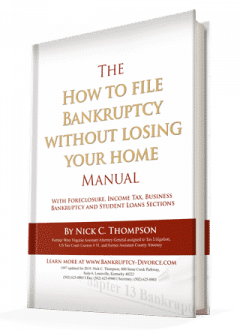Judges and trustees like the idea behind Chapter 13 which is using creativity to make a plan work. Chapter 13 step plans and Chapter 20 are just two tools that you can use to make a Chapter 13 plan affordable. For instance, a debtor might initially need lower payments. However, do you know that you can file Chapter 7 first to wipe out the unsecured debts so there are none to repay in Chapter 13? This can make Chapter 13 more affordable and feasible.
These are just two advantages to doing a step plan or Chapter 20. There are a lot more which you can take advantage of if you plan your bankruptcy rather than simply filing it. If you plan before cooking a chocolate cake, it is better than just throwing the ingredients together from different cake mixes.
Chapter 13 Step Plans & Chapter 20 Flexibility to Make a Plan Affordable
 ⎆ Why an attorney with experience matters.
⎆ Why an attorney with experience matters.
Most young attorneys have very little experience. They have not seen enough different situations to recognize the dangers and the advantages when they arise. After doing several thousand cases you can become very creative. You learn to recognize and design Chapter 13 solutions to stop a foreclosure. You learn to plan and cure tax and student loan problems in Chapter 13.
Plans which become unfeasible have to be modified later. When you calculate your plan payment you have to ensure it is affordable and feasible. The ability to see ahead prevents you from having hearings later to fix a plan that is not feasible or affordable.
Bankruptcy is like a car accident. It is perfectly fine to plan your bankruptcy to ensure it will be approved under the rules. you have to drive. You know you will have an accident one day so you use a seat belt and buy insurance. You are expected to use bankruptcy rules to keep the property and make bankruptcy affordable. Driving drunk and having accidents intentionally or with gross negligence will land you in prison. Filing bankruptcy without planning will cost you dearly. Inexperienced bankruptcy attorneys are like 16-year-olds learning how to drive for Uber. Maybe you got there.
⎆ Why I like Chapter 20 cases.
First, I understand there are two fees when you file two cases. The attorney earns an additional attorney fee when you file a Chapter 7 and 13 (Chapter 20). But you may save a lot of money doing it. If you have no assets to lose to the Chapter 7 trustee you can file two cases. If you must file a Chapter 13 to save the home why not pay back nothing to the unsecured creditors.
Imagine you have to repay 50% or 70% or 100% of your debts in Chapter 13. If you owe 100,000 in unsecured credit card and medical debts you can avoid repaying $50,000, $70,000, or $100,000 dollars over five years in Chapter 13. Simply file Chapter 7 first. Then there are no unsecured debts in Chapter 13. Sure it may cost you $1,500 or so in attorney fees and another $335 in filing fees in 2019. But if you save $50,000, $70,000, or $100,000 dollars perhaps paying out $2,000 dollars more is worth it.
After you file Chapter 7 you can then file a Chapter 13 plan which pays back 100% to the unsecured creditors. A 100% plan does not have to file annual budgets. It does not lose income tax refund checks. It has a presumption of good faith which assumes it can do almost nothing wrong. The plan is not even reviewed by the judge most of the time if it repays over 50% or 70% to the creditors.
⎆ Lien stripping in Chapter 20.
The only problem in filing a Chapter 20 is that lien stripping a second mortgage or another lien is difficult in Chapter 13 or not allowable. See this article if you need to strip a lien in Chapter 13 after you have filed a Chapter 7. In Kentucky, you can only strip the second mortgage in Chapter 13 which gets a discharge. If you use it up in Chapter 7 you can’t strip the second mortgage in Chapter 13 later.
⎆ Chapter 13 step plans.
Who says plan payments have to stay the same amount for the full five years. Chapter 13 is supposed to be affordable and the best efforts the debtor is capable of doing. If the debtor can only do $100 per month plan payments at the start of the plan but $700 dollars per month after three years, the plan payments can increase. After the second mortgage is paid off you can increase the plan payment. Also, after the car loan is paid for you can throw the old car payment amount into the plan to catch up a mortgage.
You can also have a lump sum from a house sale being paid into the plan after two or three years of smaller plan payments. These two or three years can be very affordable as long as the plan is feasible. If you have to pay off an income tax debt that is over three years old or child support debt, a step plan can help.
Feasibility primarily means a Chapter 13 plan pays back as much as a Chapter 7 does. It also means a plan repays enough to repay the priority and secured creditors at the end of the plan. However, mortgage and car loans cannot be in default at the end of the plan. See USC section 1325 about what a plan must contain.
A mortgage or car loan must be paid up to date. If the car loan is due to be paid off within the five years of the plan, it must be paid off before the plan ends. Step plans are named after mathematical step functions which increase or decrease in steps over time.
⎆ Common step plan examples.
Step plans can also start out with high payments and end with low payments. If you plan to retire in three years the plan may have high payments while you are working. When you retire the plan payments can drop.
If you plan to sell the vacation home in the fourth year of the plan you can have lower payments. You can also have four years of a vacation home. Selling a home in the final year means you can pay off the priority taxes in the final year. But the failure to sell the home means the plan would fail and you would not get a discharge.
The most common example of a step plan is when a car is paid off in the third year of the plan. After which the plan payments can increase which often shows the debtor is using his best efforts.
 Resources for Bankruptcy
Resources for Bankruptcy
Louisville Kentucky Bankruptcy Forms
How to Strip a Kentucky Mechanic Lien in Bankruptcy
How to Avoid Mortgages & Strip Liens
Filing Chapter 7 & Chapter 13 Bankruptcy
How to Win Great Chapter 13 Plan Payments
How to Strip a Kentucky Mechanic Lien in Bankruptcy
If you are thinking about filing bankruptcy, don’t delay because timing is crucial. I am here to help you. So, contact my office right away to start the conversation. Nick C. Thompson, Bankruptcy Lawyer: 502-625-0905.

 ⎆ Why an attorney with experience matters.
⎆ Why an attorney with experience matters.

